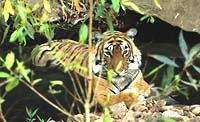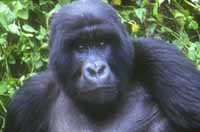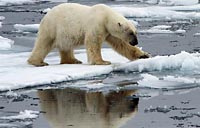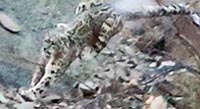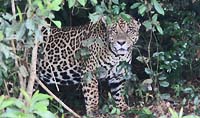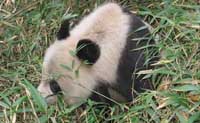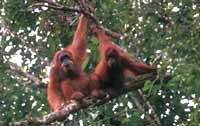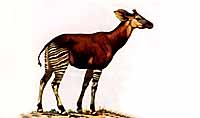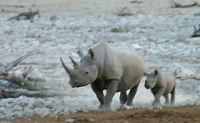# |
Species
[range] |
Photo/art [see credits]
all photos taken in wild unless stated |
Reason for choice |
DR seen? |
1 |
Tiger
Panthera tigris
[Asia] |
|
The most spectacular terrestrial predator on earth, tigers are the stuff of nightmares and then dreams. As a kid I devoured Corbett's stories; now tigers are seriously endangered, with perhaps only 2000 left. Seeing a wild tiger is the epitome of wildlife adventure. So beautiful, so deadly — and to get photos . . . priceless. |
Yes |
2 |
any Gorilla
Gorilla gorilla /
G. beringei
[c. Africa] |
|
The experience of observing a wild gorilla ranks among the best things life has to offer. Most now divide gorillas into two species: Eastern G. beringei (with lowland and montane subspecies) and Western G. gorilla (lowlands only) My chest-thumping encounter with a Western Gorilla in Gabon was heart-racing; spending an hour with mountain Eastern Gorillas in Uganda was awe-inspiring. |
Yes; 2 of 2 |
3 |
Polar Bear
Ursus maritimus
[Arctic] |
|
King of its icy realm, the Polar Bear in the undisputed top predator in the Arctic. They live on the ice in summer, feeding on seals, until drawn to shore in autumn. Experiencing the huge white bear on the Arctic icepack is very memorable. Yet global warming is causing concerns for future declines.
|
Yes |
| 4 |
Snow Leopard
Panthera uncia
[c. Asia] |
|
It seems next to impossible to see a Snow Leopard, but Adam Riley photo'd this one chasing and catching a Bhoral in nw. India. Stunning but almost invisible in its beautiful coat, even researchers can go years without seeing one. I made an effort in 2014, but we never saw one despite 9 days camping at 13,000' elev in Ladakh. |
No |
5 |
Jaguar
Panthera onca
[Mexico to s. South America] |
|
The great top predator of Neotropical forests, Jaguars are incredibly elusive. I'd seen tracks, fresh scat, a recently hit carcass on a Venezuelan road, and heard a male calling nearby, before my lucky day came when I was face to face with a big male (photo). It is an indelible experience.
|
Yes |
| 6 |
Giant Panda
Ailuropoda melanoleuca
[China] |
|
Another "almost impossible" beast in the remote mountains of interior China, its image has been adopted as a symbol for the world's threatened wildlife. Shy, elusive, and living on bamboo, only recently has eco-tourism developed a way of (maybe) seeing one [as Jon Hall did in the Qingling Mts.]. Since then, China has curbed Panda tourisim and seeing one is, again, problematic. |
No |
7 |
any Orangutan
Pongo pygmaeus
/ P. abelii
[Borneo & Sumatra]
|
|
The great red ape of wild lowland forest in Borneo & Sumatra lives in the canopy in troops with huge impressive males (who make incredible sounds) and engaging youngsters. Orangutans (pronounced oh-ron-oo-tan, not the way you have heard it) are now split into two species: Bornean P. pygmaeus and Sumatran P. abelii. |
Yes; 2 of 2 |
8 |
Sumatran Rhinoceros
Dicerorhinus sumatrensis
[Sumatra] |
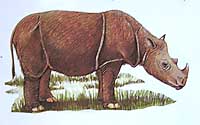 |
Sometimes termed "Asian Two-horned Rhino,"
it previously resided on mainland Malaysia, Sumatra & Borneo. Sadly, due to poaching, it seems entirely gone except for a tiny number that remain on Sumatra. Like
African rhinos, it has two horns. It is quite different than
one-horned Asian rhinos of lowland floodplains. It is smaller and its
dense hair permits existence in colder foothill climes than other rhinos. |
No |
9 |
Okapi
Okapis johnstoni
[c. Africa] |
|
This mysterious and little-known
forest animal is only one of the few even-toed ungulates to make my
"top 50" list. It seems next-to-impossible to see in the dense Congo
Basin rainforest. It is unique in many ways; its closest relative is
the Giraffe. |
No |
10 |
Black Rhinoceros
Diceros bicornis
[east & south Africa] |
|
This unpredictable vegetarian is rare and local. Both it and White Rhino Ceratotherium simum were nearly poached to extinction, but White is a placid grazer while Black is an aggressive browser. White has been reintroduced widely but Black Rhino exists only in a few pockets. |
Yes |
|
Links to all of the "top 50":
RESOURCES & CREDITS
|
FURTHER READING:
This is not an exhaustive bibliography but rather a personal choices of books, mostly in the popular literature genre, but all fact-based and well-written:
* For Tiger: Jim Corbett's (1946) Man-Eaters of Kumaon is the author's adventures in tracking down man-eating tigers (and a few leopards) in the 1920s & 1930s. Corbett was a hunter turning conservationist, and his intimate knowledge of the Indian forest shines through t adventure stories. His appreciation for tigers is immense; today, Corbett National Park – one of the best tiger reserves – is named for him. I also absolutely rave about Richard Ives' (1996) Of Tigers and Men: Entering the Age of Extinction, the story of his own experiences in trying to see tigers while running into the famous and infamous in the tiger field. Birders will especially enjoy his portrait of a recluse birder he meets on Sumatra; just a fascinating book from beginning to end. For life history material, Valmik Thapar's various books are great; I particularly enjoyed the text and photos in Tiger: Portrait of a Predator (1999). The frontispiece photo is the equivalent of a Robert Bateman painting on film. Finally, Peter Matthiessen's (2000) Tigers in the Snow combines rich text with Maurice Hornocker's stunning photos of Siberian tigers.
* For Gorilla: Obviously, Dian Fossey's (1983) Gorillas in the Mist brought the plight of the Mountain Gorillas to the world, but it was George Schaller's research in The Mountain Gorilla: Behavior and Ecology (1963) and The Year of the Gorilla (1964) the did the foundational work.
* For Snow Leopard: Peter Matthiessen's (1978) The Snow Leopard was a fascinating metaphysical musing while in a prolonged search (unsuccessful) to see a Snow Leopard, with much of interest about the habitat. I most enjoyed the research work in remote Nepal , along with the many problems that were entailed, described in Darla Hillard's (1989) Vanishing Tracks: Four Years among the Snow Leopards of Nepal.
* For Orangutan: there are several books on research or ruminations about Orangutans relationship to Man, but I most enjoyed John MacKinnon's (1974) In Search of the Red Ape on his field observations in Borneo.
* For Giant Panda: George B. Schaller's (1993) The Last Panda is the classic.
* For Jaguar: True appreciation for this great cat is achieved in reading about man's struggle to establish the world's first Jaguar preserve (in Belize) in Alan Rabinowitz' (1986) Jaguar.
* For Polar Bear: I have read rather little on this subject, but Norbert Rosing's (1994) photo book The World of the Polar Bear has some great shots, and gives a good introduction to the 'scene' at Churchill on Hudson Bay in the fall.
* For Black Rhinoceros: very entertaining first person stories about research on Black Rhino in the Namibian deserts is in Carol Cunningham & Joel Berger's (1997) Horn of Darkness: Rhinos on the Edge. They showed, despite many obstacles, that the controversial 'environmental' practice of dehorning rhinos (to save them from poachers) didn't work for ecological reasons (mother rhinos need horns to protect young from hyenas).
CREDITS:
All artworks are copyrighted by the artist (as detailed below) and are
either used with permission or are posted here in reliance on the
non-commercial "fair use" doctrine; all rights are reserved by the
artist
* Helmut Diller painted Okapi (from
Haltenorth & Diller's 1980 Field Guide to the Mammals of
Africa including Madagascar)
* Karen Phillipps painted Sumatran Rhinoceros (Payne &
Francis's 1985 Field Guide to Mammals of Borneo)
All the photographs are copyrighted by the photographer (as detailed below) and are used with permission; all rights are reserved to the photographer
* Adam Riley photographed Snow Leopard (Ladakh, India)
* Jon Hornbuckle photographed Mountain Gorilla (Rwanda)
* Mr. Zhang, Jon Hall's guide in Qingling Mts., photographed Giant Panda (China)
* Don Roberson photographed Tiger (India), Orangutan (Sumatra, Indonesia), Jaguar (Brazil), Polar Bear (Svalbard), and Black Rhinoceros (Namibia)
|
TOP
Page created 1-6 June 2002, updated 20 Aug 2002, revised 6 Dec 2014 & 18 Feb 2021 |
|
